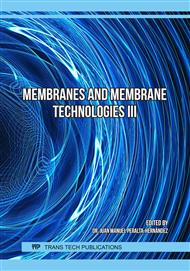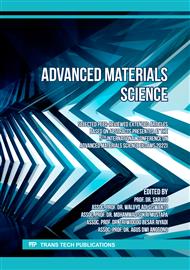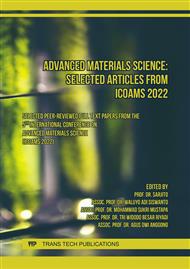p.3
p.11
p.19
p.27
p.35
p.41
p.49
p.57
Preparation of PVA/Chitosan/Zeolite Composite and its Antibacterial Activity for Water Treatment
Abstract:
Zeolite filled polymer has recently emerged as a promising material with its immense applications. When taking water treatment into account, it is potentially an antibacterial film. In this study, poly vinyl alcohol (PVA)/chitosan/zeolite composite membranes were prepared with different proportions, including 5:1, 8:1 and 10:1 of PVA/chitosan ratios. Zeolite available in the film aimed to improve the morphology and the efficiency in water environment, with loading dosages of 10, 20 and 50 wt%, respectively. Characterization using scanning electron microscopy (SEM), SEM/EDX and X-ray diffraction (XRD) were also conducted to have a better view of the membranes. The results of antibacterial activity against aerobic bacteria using the 3MTM PetrifilmTM Aerobic Count (AC) Plate. The results indicated that pure chitosan film gave 75.7% of antibacterial activity and the composite film with 5:1 ratio of PVA/chitosan was the effective proportion, revealing the antibacterial rate around 53% to the applications of bacteria inhibition. The time test of antibacterial also reduced the level of bacteria in water environment to 2900 CFU of aerobic bacteria.
Info:
Periodical:
Pages:
41-47
Citation:
Online since:
January 2023
Authors:
Price:
Сopyright:
© 2023 Trans Tech Publications Ltd. All Rights Reserved
Share:
Citation:





